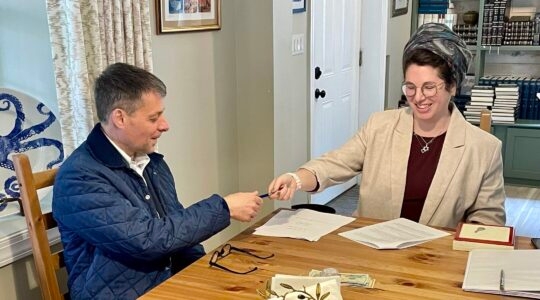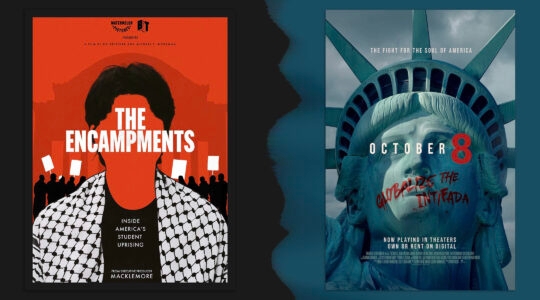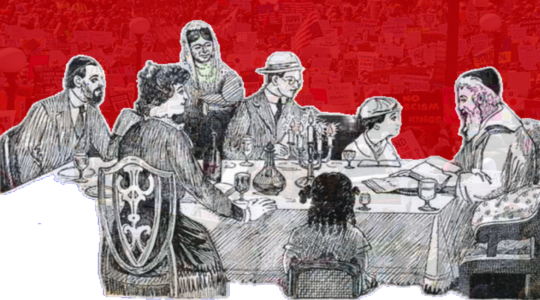The Red Sox were on the precipice of a sweep of the 2004 World Series, and all the TV commentators could focus on during in Game 4 was when their team would blow it. After Boston won that night, fans complained that the media ignored the excitement and action on the field because of their predetermined story frame. What the media also failed to notice was the bigger picture — in that game, the Red Sox established a strong organization that was built to compete for the foreseeable future.
I am reminded of this missed opportunity as I read some of the reports of the recent exuberant United Synagogue (USCJ) Centennial in Baltimore. Taking place in the shadow of the sobering Pew survey, many journalists focused their stories on the demographic decline of liberal Judaism in general and Conservative Judaism in particular.
But by ignoring the dancing in the aisles, the contagious ruach ITAL (spirit) and heartfelt singing of the over 180 youth and college students — as well as the honest and constructive dialogue and learning taking place from morning till the late evening hours — these reporters missed the real story, which is the hopefulness and new energy generated by United Synagogue at this inclusive event.
One participant described the eclectic, purpose-driven Centennial as “the Woodstock of Conservative Judaism.” There were innumerable moving, memorable moments. Participants cried as 600 of us celebrated Havdalah together, when Andrew Lustig shared his “I am Jewish” poem and Rabbi Steven Wernick concluded the 1,200-person-strong conference with a passionate plea for us to keep the conversation going and devote ourselves to the “tachlis of transformation.”
There was celebration aplenty but what contributed to the sense of optimism at our Centennial was the discourse about the challenges Conservative synagogues face today. The tagline of this conference, “The Conversation of the Century,” was not just a catchy slogan. Rather, it reflects our commitment to convene open, relevant, ongoing discussions about what is working in Conservative Jewish life and what is in need to change.
This candid, non-hierarchical approach took many participants by surprise.
More than once, I had to explain to those who were caught off-guard by the candor of our conversations that the whole point of the conference was to start portable conversations to flame the fire of community and commitment to Jewish life. This approach utilizes the mode of conversation as a vehicle to foster new relationships, new ideas and new strategic partnerships — especially between parties who disagree.
You see, at a moment when demographics are rapidly in flux, we don’t have the luxury of affirmation. This is precisely why Rabbi Edward Feinstein proclaimed with the intensity of a shofar blast that “our house is on fire.” His words perfectly capture the urgency with which the Centennial was designed over the last 18 months.
By forecasting how to address this demographic “fire,” USCJ was prepared with buckets of water. More importantly, Conservative Jews answered the call from every corner of North America to serve as our volunteer firefighter force.
From the moment our Centennial opened, the spiritual energy was palpable. Our carefully constructed conference showcased the vibrancy of Jewish life and offered inspiration and guidance as to what we can do to engage our home congregations and communities upon our return.
Our mission was to fan the flames of Conservative Judaism, so that people would leave inspired and prepared to build vibrant communities of purpose. Clearly this message resonated because we had a 600-percent increase over our last conference. That among our numbers were over 160 rabbis and cantors reflects the emerging sense that a stronger future can only be created when clergy, professional and lay leadership are in alignment with one another. The presence of the leaders of the various arms of Conservative Jewish life added immeasurably to the success of our gathering. We became a Big Tent in the truest sense.
Our Conversation of the Century dealt with where we are going in the future and how can we get there together. With this in mind, every presentation was designed with concrete takeaways so that the conversation and momentum will continue when participants return home.
Inspiration at our Centennial also stemmed from being in the room with multiple generations — literally from newborns to senior citizens. We made a conscious effort to engage our high school and college students. With our youth invited to the table, this was clearly not just a conversation about the future; but rather a conversation with the future.
Recently Jeph Loeb, Marvel Comic’s top TV executive, asserted: “People go to the movies to escape. People watch television to be a part of something.” Loeb’s analysis applies to our Centennial. People came to be part of something — the great reset moment of Conservative Judaism, as Rabbi Wernick had articulated.
Yes, we had a great event by every objective standard. There was dancing in the aisles. There were tears of joy. There were standing-room-only sessions. There was spirit and energy and singing. However, the Centennial’s potential impact will only be achieved if the 1,200 participants bring their learning, conversations, takeaways and inspiration home so they themselves can become integral players in the unfolding story of Conservative Judaism in the 21st century.
While some may see a narrative of decline, United Synagogue and the members of our “fire brigade” recognize that what took place in Baltimore was a moment of rebirth, a spiritual World Series that can be won, a Woodstock experience that will keep us humming for the foreseeable future.
I could not agree more with Rabbi Feinstein’s statement that a fire is blazing. It is the passion ignited by our ambitious ingathering, the brilliant memory of what we once were and luminous dream of what we have yet to become.
The passion rekindled by our Centennial has set us on fire. In Baltimore, we recalled how brightly the flame of Conservative Judaism used to burn. Nevermore shall we forget what we recovered. Ultimately, this is the most important takeaway, the spark that will ignite the tachlis of the transformation of the vital center of Jewish life.
Rabbi Charles E. Savenor is the director of kehilla enrichment for United Synagogue and served as program director of the Centennial.
The New York Jewish Week brings you the stories behind the headlines, keeping you connected to Jewish life in New York. Help sustain the reporting you trust by donating today.




